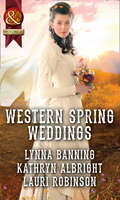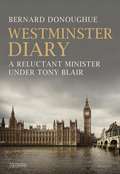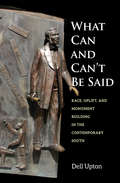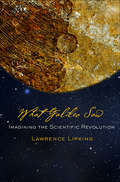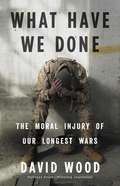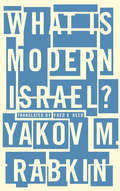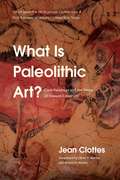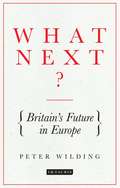- Table View
- List View
Western Spring Weddings: The City Girl And The Rancher / His Springtime Bride / When A Cowboy Says I Do (Mills And Boon Historical Ser.)
by Lynna Banning Kathryn Albright Lauri RobinsonSPRING WEDDING FEVER IN THE WILD, WILD WEST! The City Girl and the Rancher by Lynna BanningPenniless, Clarissa Seaforth leaps at gruff rancher Graydon Harris’s offer to become his cook. She’s never cared for a man before, but surely it can’t be hard to learn…?
Western Sufism: From the Abbasids to the New Age
by Mark SedgwickWestern Sufism is sometimes dismissed as a relatively recent "new age" phenomenon, but in this book Mark Sedgwick argues that it has deep roots, both in the Muslim world and in the West. In fact, although the first significant Western Sufi organization was not established until 1915, the first Western discussion of Sufism was printed in 1480, and Western interest in Sufi thought goes back to the thirteenth century. Sedgwick starts with the earliest origins of Western Sufism in late antique Neoplatonism and early Arab philosophy, and traces later origins in repeated intercultural transfers from the Muslim world to the West, in the thought of the European Renaissance and Enlightenment, and in the intellectual and religious ferment of the nineteenth century. He then follows the development of organized Sufism in the West from 1915 until 1968, the year in which the first Western Sufi order based on purely Islamic models was founded. Western Sufism shows the influence of these origins, of thought both familiar and less familiar: Neoplatonic emanationism, perennialism, pantheism, universalism, and esotericism. Western Sufism is the product not of the new age but of Islam, the ancient world, and centuries of Western religious and intellectual history. Using sources from antiquity to the internet, Sedgwick demonstrates that the phenomenon of Western Sufism draws on centuries of intercultural transfers and is part of a long-established relationship between Western thought and Islam.
Westminster Diary: A Reluctant Minister under Tony Blair
by Bernard DonoughueOn 2nd May 1997, Tony Blair swept into Downing Street, ending almost twenty years of Conservative government and beginning a decade as Prime Minister. Bernard Donoughue, a Labour peer in the House of Lords, chronicled the path to this momentous election victory in his diaries and this volume sheds new light on the process of forming government and on life working as a minister in the House of Lords. Infused with Donoughue's trademark wit and insight, the diaries covers daily life for a working peer – from the committees, bill discussion and public appearances to political spats – both policy-related and personal. Donoughue also casts a wry glance at a peer's extra-curricular events – from dinners and other high-profile social events to his own favourite hobby, horse-racing. Featuring a cast of high-profile political characters, this book is a must-read for fans of political diaries and anyone with an interest in the inside workings of Westminster
What Can and Can't Be Said: Race, Uplift, and Monument Building in the Contemporary South
by Dell UptonAn original study of monuments to the civil rights movement and African American history that have been erected in the U.S. South over the past three decades, this powerful work explores how commemorative structures have been used to assert the presence of black Americans in contemporary Southern society. The author cogently argues that these public memorials, ranging from the famous to the obscure, have emerged from, and speak directly to, the region’s complex racial politics since monument builders have had to contend with widely varied interpretations of the African American past as well as a continuing presence of white supremacist attitudes and monuments.
What Did the Baby Boomers Ever Do For Us? (Routledge Revivals Ser.)
by Francis BeckettThe first of those born in the baby boom following the Second World War came of age in the radical sixties. Not since 1918 had the young talked serious revolutionary politics as they did then. But in 1918, the men who came back from the war knew that the world was amiss, and what they had to do about it. When at last the generation that fought the Great War came to power, they changed the world. By contrast, the generation that came after decayed fast. For the first time since the Second World War, there was money, there was safe sex, there was freedom, and no one bothered to stop and remember the price earlier generations had paid for this. Most of them hardly realised the privations of their parents, and the struggle that had taken place to ensure that they were not equally deprived. What began as the most radical-sounding generation for half a century turned into a random collection of youthful style gurus, sharp-toothed entrepreneurs and management consultants who believed revolution meant new ways of selling things; and Thatcherites, who thought freedom meant free markets, not free people. At last it found its most complete expression in New Labour, which had no idea what either revolution or freedom meant, but rather liked the sound of the words. While the philosophy of the sixties seemed progressive at the time, the baby boomers we remember are not the political reformers, but the millionaires. In What Did the Baby Boomers Ever Do for Us? Francis Beckett argues that the children of the '60s betrayed the generations that came before and after, and that the true legacy of the swinging decade is ashes.
What Galileo Saw: Imagining the Scientific Revolution
by Lawrence LipkingThe Scientific Revolution of the seventeenth century has often been called a decisive turning point in human history. It represents, for good or ill, the birth of modern science and modern ways of viewing the world. In What Galileo Saw, Lawrence Lipking offers a new perspective on how to understand what happened then, arguing that artistic imagination and creativity as much as rational thought played a critical role in creating new visions of science and in shaping stories about eye-opening discoveries in cosmology, natural history, engineering, and the life sciences. When Galileo saw the face of the Moon and the moons of Jupiter, Lipking writes, he had to picture a cosmos that could account for them. Kepler thought his geometry could open a window into the mind of God. Francis Bacon's natural history envisioned an order of things that would replace the illusions of language with solid evidence and transform notions of life and death. Descartes designed a hypothetical "Book of Nature" to explain how everything in the universe was constructed. Thomas Browne reconceived the boundaries of truth and error. Robert Hooke, like Leonardo, was both researcher and artist; his schemes illuminate the microscopic and the macrocosmic. And when Isaac Newton imagined nature as a coherent and comprehensive mathematical system, he redefined the goals of science and the meaning of genius. What Galileo Saw bridges the divide between science and art; it brings together Galileo and Milton, Bacon and Shakespeare. Lipking enters the minds and the workshops where the Scientific Revolution was fashioned, drawing on art, literature, and the history of science to reimagine how perceptions about the world and human life could change so drastically, and change forever.
What Have We Done: The Moral Injury of Our Longest Wars
by David WoodFrom Pulitzer Prize-¬?winning journalist David Wood, a battlefield view of moral injury, the signature wound of America's 21st century wars. Most Americans are now familiar with Post Traumatic Stress Disorder (PTSD) and its prevalence among troops. In this groundbreaking new book, David Wood examines the far more pervasive yet less understood experience of those we send to war: moral injury, the violation of our fundamental values of right and wrong that so often occurs in the impossible moral dilemmas of modern conflict. Featuring portraits of combat veterans and leading mental health researchers, along with Wood's personal observations of war and the young Americans deployed in Iraq and Afghanistan, What Have We Done offers an unflinching look at war and those who volunteer for it: the thrill and pride of service and, too often, the scars of moral injury. Impeccably researched and deeply personal, What Have We Done is a compassionate, finely drawn study of modern war and those caught up in it. It is a call to acknowledge our newest generation of veterans by listening intently to them and absorbing their stories; and, as new wars approach, to ponder the inevitable human costs of putting American "boots on the ground."
What If the Queen Should Die?
by John-Paul FlintoffWindsor Castle, 1714. Queen Anne has known her share of tragedy and grief: betrayed by her father; plagued by illness and obesity; cursed to lose all seventeen of her children.Now she is dying with no living offspring, and the question of who will succeed her hangs over the court, fuelling political intrigue and fear. There are two likely successors: James Stuart, the half-brother she has always refused to acknowledge, and George of Hanover, the cousin who once turned her down for marriage.Neither is ideal. She hates them both.As courtiers, politicians and sycophants plot to steer the succession to their own advantage, Queen Anne must finally face the past. For nothing can be resolved until she comes to terms with her children's deaths and repairs the terrible wrong she committed many years before . . .With familiar characters – including three of the most important writers in English literature: Daniel Defoe (Robinson Crusoe), Jonathan Swift (Gulliver's Travels), and fashionable poet Alexander Pope – and a gripping plot, What If the Queen Should Die? is the thrilling historical tale of Britain's most tragic queen.
What is Coming? A Forecast of Things after the War (The World At War)
by H. G. WellsProphecy may vary between being an intellectual amusement and a serious occupation; serious not only in its intentions, but in its consequences. For it is the lot of prophets who frighten or disappoint to be stoned. But for some of us moderns, who have been touched with the spirit of science, prophesying is almost a habit of mind. (Excerpt from book)
What Is History For?: Johann Gustav Droysen and the Functions of Historiography (Making Sense of History #17)
by Arthur Alfaix AssisA scholar of Hellenistic and Prussian history, Droysen developed a historical theory that at the time was unprecedented in range and depth, and which remains to the present day a valuable key for understanding history as both an idea and a professional practice. Arthur Alfaix Assis interprets Droysen’s theoretical project as an attempt to redefine the function of historiography within the context of a rising criticism of exemplar theories of history, and focuses on Droysen’s claim that the goal underlying historical writing and reading should be the development of the subjective capacity to think historically. In addition, Assis examines the connections and disconnections between Droysen’s theory of historical thinking, his practice of historical thought, and his political activism. Ultimately, Assis not only shows how Droysen helped reinvent the relationship between historical knowledge and human agency, but also traces some of the contradictions and limitations inherent to that project.
What is Intellectual History? (What is History?)
by Richard WhatmoreWhat is intellectual history? Those who practice intellectual history have described themselves as eavesdroppers upon the conversations of the past, explorers of alien ideological worlds, and translators between historic societies and our own, while their critics have often derided them as narrow-mindedly studying the ideas of dead white men. Some consider the discipline to be among the most important in the humanities and social sciences because it facilitates a better understanding of contemporary ideological programmes and facilitates their rational evaluation.In this engaging and refreshing introduction to the field, Richard Whatmore begins by examining the historical development of intellectual history, before dissecting its various methodological debates. He presents various alternative ways in which we should think about intellectual history, as well as presenting his own very clear definition of the field. Drawing on a wide range of historical examples, Whatmore shows how ideas - philosophical, political, religious, scientific, artistic - originated in their historical context and how they were both shaped by, and helped to shape, the societies in which they originated. He ends by casting a critical eye over the current state of intellectual history, and a brief discussion of how it might develop in the future.What is Intellectual History? will become an essential textbook for scholars and students of intellectual history, philosophy, politics, and the humanities.
What is Modern Israel?
by Yakov M. RabkinFew countries provoke as much passion and controversy as Israel. What is Modern Israel? convincingly demonstrates that its founding ideology - Zionism - is anything but a simple reaction to antisemitism. Dispelling the notion that every Jew is a Zionist and therefore a natural advocate for the state of Israel, Yakov Rabkin points to the Protestant roots of Zionism, in order to explain the particular support Israel musters in the United States. *BR**BR*Drawing on many overlooked pages of history, including English, French, Hebrew, Yiddish and Russian sources, Yakov Rabkin shows that Zionism was conceived as a sharp break with Judaism and Jewish continuity. Israel’s past and present must be seen in the context of European ethnic nationalism, colonial expansion and geopolitical interests, rather than as an incarnation of Biblical prophecies or a culmination of Jewish history.
What Is Paleolithic Art?: Cave Paintings and the Dawn of Human Creativity
by Jean ClottesWas it a trick of the light that drew our Stone Age ancestors into caves to paint in charcoal and red hematite, to watch the heads of lions, likenesses of bison, horses, and aurochs in the reliefs of the walls, as they flickered by firelight? Or was it something deeper—a creative impulse, a spiritual dawn, a shamanistic conception of the world efflorescing in the dark, dank spaces beneath the surface of the earth where the spirits were literally at hand? In this book, Jean Clottes, one of the most renowned figures in the study of cave paintings, pursues an answer to this “why” of Paleolithic art. While other books focus on particular sites and surveys, Clottes’s work is a contemplative journey across the world, a personal reflection on how we have viewed these paintings in the past, what we learn from looking at them across geographies, and what these paintings may have meant—what function they may have served—for their artists. Steeped in Clottes’s shamanistic theories of cave painting, What Is Paleolithic Art? travels from well-known Ice Age sites like Chauvet, Altamira, and Lascaux to visits with contemporary aboriginal artists, evoking a continuum between the cave paintings of our prehistoric past and the living rock art of today. Clottes’s work lifts us from the darkness of our Paleolithic origins to reveal, by firelight, how we think, why we create, why we believe, and who we are.
What Is Paleolithic Art?: Cave Paintings and the Dawn of Human Creativity
by Jean ClottesWas it a trick of the light that drew our Stone Age ancestors into caves to paint in charcoal and red hematite, to watch the heads of lions, likenesses of bison, horses, and aurochs in the reliefs of the walls, as they flickered by firelight? Or was it something deeper—a creative impulse, a spiritual dawn, a shamanistic conception of the world efflorescing in the dark, dank spaces beneath the surface of the earth where the spirits were literally at hand? In this book, Jean Clottes, one of the most renowned figures in the study of cave paintings, pursues an answer to this “why” of Paleolithic art. While other books focus on particular sites and surveys, Clottes’s work is a contemplative journey across the world, a personal reflection on how we have viewed these paintings in the past, what we learn from looking at them across geographies, and what these paintings may have meant—what function they may have served—for their artists. Steeped in Clottes’s shamanistic theories of cave painting, What Is Paleolithic Art? travels from well-known Ice Age sites like Chauvet, Altamira, and Lascaux to visits with contemporary aboriginal artists, evoking a continuum between the cave paintings of our prehistoric past and the living rock art of today. Clottes’s work lifts us from the darkness of our Paleolithic origins to reveal, by firelight, how we think, why we create, why we believe, and who we are.
What Is Paleolithic Art?: Cave Paintings and the Dawn of Human Creativity
by Jean ClottesWas it a trick of the light that drew our Stone Age ancestors into caves to paint in charcoal and red hematite, to watch the heads of lions, likenesses of bison, horses, and aurochs in the reliefs of the walls, as they flickered by firelight? Or was it something deeper—a creative impulse, a spiritual dawn, a shamanistic conception of the world efflorescing in the dark, dank spaces beneath the surface of the earth where the spirits were literally at hand? In this book, Jean Clottes, one of the most renowned figures in the study of cave paintings, pursues an answer to this “why” of Paleolithic art. While other books focus on particular sites and surveys, Clottes’s work is a contemplative journey across the world, a personal reflection on how we have viewed these paintings in the past, what we learn from looking at them across geographies, and what these paintings may have meant—what function they may have served—for their artists. Steeped in Clottes’s shamanistic theories of cave painting, What Is Paleolithic Art? travels from well-known Ice Age sites like Chauvet, Altamira, and Lascaux to visits with contemporary aboriginal artists, evoking a continuum between the cave paintings of our prehistoric past and the living rock art of today. Clottes’s work lifts us from the darkness of our Paleolithic origins to reveal, by firelight, how we think, why we create, why we believe, and who we are.
What Is Paleolithic Art?: Cave Paintings and the Dawn of Human Creativity
by Jean ClottesWas it a trick of the light that drew our Stone Age ancestors into caves to paint in charcoal and red hematite, to watch the heads of lions, likenesses of bison, horses, and aurochs in the reliefs of the walls, as they flickered by firelight? Or was it something deeper—a creative impulse, a spiritual dawn, a shamanistic conception of the world efflorescing in the dark, dank spaces beneath the surface of the earth where the spirits were literally at hand? In this book, Jean Clottes, one of the most renowned figures in the study of cave paintings, pursues an answer to this “why” of Paleolithic art. While other books focus on particular sites and surveys, Clottes’s work is a contemplative journey across the world, a personal reflection on how we have viewed these paintings in the past, what we learn from looking at them across geographies, and what these paintings may have meant—what function they may have served—for their artists. Steeped in Clottes’s shamanistic theories of cave painting, What Is Paleolithic Art? travels from well-known Ice Age sites like Chauvet, Altamira, and Lascaux to visits with contemporary aboriginal artists, evoking a continuum between the cave paintings of our prehistoric past and the living rock art of today. Clottes’s work lifts us from the darkness of our Paleolithic origins to reveal, by firelight, how we think, why we create, why we believe, and who we are.
What is Sexual History? (What is History?)
by Jeffrey WeeksUntil the 1970s the history of sexuality was a marginalized practice. Today it is a flourishing field, increasingly integrated into the mainstream and producing innovative insights into the ways in which societies shape and are shaped by sexual values, norms, identities and desires. In this book, Jeffrey Weeks, one of the leading international scholars in the subject, sets out clearly and concisely how sexual history has developed, and its implications for our understanding of the ways we live today. The emergence of a new wave of feminism and lesbian and gay activism in the 1970s transformed the subject, heavily influenced by new trends in social and cultural history, radical sociological insights and the impact of Michel Foucault’s work. The result was an increasing emphasis on the historical shaping of sexuality, and on the existence of many different sexual meanings and cultures on a global scale. With chapters on, amongst others, lesbian, gay and queer history, feminist sexual history, the mainstreaming of sexual history, and the globalization of sexual history, What is Sexual History? is an indispensable guide to these developments.
What is Sexual History? (What is History?)
by Jeffrey WeeksUntil the 1970s the history of sexuality was a marginalized practice. Today it is a flourishing field, increasingly integrated into the mainstream and producing innovative insights into the ways in which societies shape and are shaped by sexual values, norms, identities and desires. In this book, Jeffrey Weeks, one of the leading international scholars in the subject, sets out clearly and concisely how sexual history has developed, and its implications for our understanding of the ways we live today. The emergence of a new wave of feminism and lesbian and gay activism in the 1970s transformed the subject, heavily influenced by new trends in social and cultural history, radical sociological insights and the impact of Michel Foucault’s work. The result was an increasing emphasis on the historical shaping of sexuality, and on the existence of many different sexual meanings and cultures on a global scale. With chapters on, amongst others, lesbian, gay and queer history, feminist sexual history, the mainstreaming of sexual history, and the globalization of sexual history, What is Sexual History? is an indispensable guide to these developments.
What is the Genus? (Lecture Notes in Mathematics #2162)
by Patrick Popescu-PampuExploring several of the evolutionary branches of the mathematical notion of genus, this book traces the idea from its prehistory in problems of integration, through algebraic curves and their associated Riemann surfaces, into algebraic surfaces, and finally into higher dimensions. Its importance in analysis, algebraic geometry, number theory and topology is emphasized through many theorems. Almost every chapter is organized around excerpts from a research paper in which a new perspective was brought on the genus or on one of the objects to which this notion applies. The author was motivated by the belief that a subject may best be understood and communicated by studying its broad lines of development, feeling the way one arrives at the definitions of its fundamental notions, and appreciating the amount of effort spent in order to explore its phenomena.
What is the History of Knowledge? (What is History?)
by Peter BurkeWhat is the history of knowledge? This engaging and accessible introduction explains what is distinctive about the new field of the history of knowledge (or, as some scholars say, ‘knowledges in the plural’) and how it differs from the history of science, intellectual history, the sociology of knowledge or from cultural history. Leading cultural historian, Peter Burke, draws upon examples of this new kind of history from different periods and from the history of India, East Asia and the Islamic world as well as from Europe and the Americas. He discusses some of the main concepts used by scholars working in the field, among them ‘order of knowledge’, ‘situated knowledge’ and ‘knowledge society’. This book tells the story of the transformation of relatively raw ‘information’ into knowledge via processes of classification, verification and so on, the dissemination of this knowledge and finally its employment for different purposes, by governments, corporations or private individuals. A concluding chapter identifies central problems in the history of knowledge, from triumphalism to relativism, together with attempts to solve them. The only book of its kind yet to be published, What is the History of Knowledge? will be essential reading for all students of history and the humanities in general, as well as the interested general reader.
What is Urban History? (What is History?)
by Shane EwenUrban history is a well-established and flourishing field of historical research. Written by a leading scholar, this short introduction demonstrates how urban history draws upon a wide variety of methodologies and sources, and has been integral to the rise of interdisciplinary and comparative approaches to history since the second half of the twentieth century. Shane Ewen offers an accessible and clearly written guide to the study of urban history for the student, teacher, researcher or general reader who is new to the field and interested in learning about past approaches as well as key themes, concepts and trajectories for future research. He takes a global and comparative viewpoint, combining a discussion of classic texts with the latest literature to illustrate the current debates and controversies across the urban world. The historiography of the field is mapped out by theme, including new topics of interest, with a particular focus on space and social identity, power and governance, the built environment, culture and modernity, and the growth and spread of transnational networking. By discussing a number of historic and fast-growing cities across the world, What is Urban History? demonstrates the importance of the history of urban life to our understanding of the world, both in the present and the future. As a result, urban history remains pivotal for explaining the continued growth of towns and cities in a global context, and is particularly useful for identifying the various problems and solutions faced by fast-growing megacities in the developing world.
What is Urban History? (What is History?)
by Shane EwenUrban history is a well-established and flourishing field of historical research. Written by a leading scholar, this short introduction demonstrates how urban history draws upon a wide variety of methodologies and sources, and has been integral to the rise of interdisciplinary and comparative approaches to history since the second half of the twentieth century. Shane Ewen offers an accessible and clearly written guide to the study of urban history for the student, teacher, researcher or general reader who is new to the field and interested in learning about past approaches as well as key themes, concepts and trajectories for future research. He takes a global and comparative viewpoint, combining a discussion of classic texts with the latest literature to illustrate the current debates and controversies across the urban world. The historiography of the field is mapped out by theme, including new topics of interest, with a particular focus on space and social identity, power and governance, the built environment, culture and modernity, and the growth and spread of transnational networking. By discussing a number of historic and fast-growing cities across the world, What is Urban History? demonstrates the importance of the history of urban life to our understanding of the world, both in the present and the future. As a result, urban history remains pivotal for explaining the continued growth of towns and cities in a global context, and is particularly useful for identifying the various problems and solutions faced by fast-growing megacities in the developing world.
What Next?: Britain's Future in Europe
by Peter Wilding2016 is a historic year for Britain as 40 years of uncertainty over Europe ends. After the referendum, what will be Britain's role in Europe and, indeed, the world? What next, indeed? Peter Wilding offers an arresting answer, plotting out a new course for Britain's troubled relationship with Europe. He channels the pride Britain draws from its heritage through the prejudice Britain has historically had against Europe, and proposes a new popular-based platform for British influence in Europe: 'smart power'. Wilding identifies how British leaders from Pitt to Cameron have attempted to use exactly this 'smart power' in their approach to Europe. He tells the story of their shared experiences in forging Churchill's strategy - a long-term plan which put Britain at the heart of Europe and the Commonwealth and alongside the United States - and applies it to Britain today. Outlining a new approach for Britain's leaders, Wilding proposes a new, positive vision to position Britain in a fast-changing and fractured world. His book will provide valuable new perspectives on the debate about what Britain does next after the EU referendum.
What the British Did: Two Centuries in the Middle East
by Peter MangoldBritain has been engaged in the Middle East for over two centuries. During the Napoleonic Wars it expelled the French from Egypt. During World War I it helped to dismantle the Ottoman empire. During World War II, it defeated the Italians and Germans. In the post-war years, it attempted to reassert its domination of the Middle East but with little success. Today British forces in the region are fighting ISIS. Variously seen as intruders by most of the local populations and nationalists and as protectors by local pliant rulers, the British have been key arbiters in Middle Eastern politics. They created new states, determined who could hold power, resolved disputes and offered security to their clients. In this major new study, Peter Mangold shows how Britain sought to protect its changing interests in the region and assesses the British response to Arab nationalism. He examines the successes and failures of British policy and the reasons it has often proved controversial and accident prone. And he evaluates Britain's complex legacy in the Middle East – its contribution to the stability of Jordan (at least to date) and the Gulf states, set against the instability which has plagued Iraq and the unresolved Palestine conflict. In tracing the history of Britain's relationship with the Middle East, Mangold reveals how Britain's involvement in the Middle East sowed the seeds for today's crises.
What's Wrong with the United Nations and How to Fix It (What's Wrong?)
by Thomas G. WeissSeven decades after its establishment, the United Nations and its system of related organizations and programs are perpetually in crisis. While the twentieth-century’s world wars gave rise to ground-breaking efforts at international organization in 1919 and 1945, today’s UN is ill-equipped to deal with contemporary challenges to world order. Neither the end of the Cold War nor the aftermath of 9/11 has led to the “next generation” of multilateral institutions. But what exactly is wrong with the UN that makes it incapable of confronting contemporary global challenges and, more importantly, can we fix it? In this revised and updated third edition of his popular text, leading scholar of global governance Thomas G. Weiss takes a diagnose-and-cure approach to the world organization’s inherent difficulties. In the first half of the book, he considers: the problems of international leadership and decision making in a world of self-interested states; the diplomatic complications caused by the artificial divisions between the industrialized North and the global South; the structural problems of managing the UN’s many overlapping jurisdictions, agencies, and bodies; and the challenges of bureaucracy and leadership. The second half shows how to mitigate these maladies and points the way to a world in which the UN’s institutional ills might be “cured.” Weiss’s remedies are not based on pious hopes of a miracle cure for the UN, but rather on specific and encouraging examples that could be replicated. With considered optimism and in contrast to received wisdom, he contends that substantial change is both plausible and possible.
